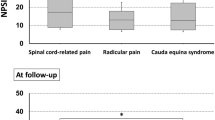Abstract
This study was made in order to define risk factors for patients requiring spinal opioid therapy developing painful spastic muscle tone together with myoclonus and spinal jerking (MSJ). The case histories of 75 patients, all receiving morphine spinally, were retrospectively analysed and, of these, 10 suffered from the MSJ syndrome. The following were taken as evaluation criteria: age, sex, performance status, duration and dosage of previous systemic and current spinal morphine therapy, concomitant analgesic and co-analgesic medication, pretreatment of the dorsal column and neurological dysfunction due to damage either of the nerval plexus or of the medulla spinalis. As a result, high spinal morphine doses in conjunction with pathological changes within the spine were shown to be risk factors for this syndrome. Changing from spinal to systemic morphine application or reduction of spinal doses together with the addition of systemic morphine led to complete recovery from MSJ. As underlying mechanism, an imbalance between the activity of spinal and central opioid receptors and/or toxic morphine effects on the medulla spinalis are discussed. In conclusion, great care should be taken when applying morphine to the spine in patients with neurological dysfunction due to an apparent pathology of the medulla spinalis, especially if large amounts of morphine are likely to be required. Some systemic application of morphine might reduce the risk of patients developing MSJ syndrome.
Similar content being viewed by others
References
Brose WG, Tanelian DL, Brodsky JB, Mark JBD, Cousins MJ (1991) CSF and blood pharmacokinetics of hydromorphone and morphine following lumbar epidural administration. Pain 45:11–15
Colton T (1974) Statistics in medicine. Little, Brown & Co, Boston
Erdine S, Aldemir T (1991) Long-term results of peridural morphine in 225 patients. Pain 45:155–159
Frenk H (1985) Pro- and anticonvulsant actions of morphine and the endogenous opioids: involvement and interactions of multiple opiate and non-opiate systems. Brain Res 287:197–210
Frenk H, Liban A, Balamuth R, Urca G (1982) Opiate and non-opiate aspects of morphine induced seizures. Brain Res 253:253–261
Frenk H, Watkins LR, Mayer DJ (1984) Differential behavioral effects induced by intrathecal microinjection of opiates: comparison of convulsive and cataleptic effects produced by morphine, methadone, and d-Ala2-methionine-enkephalinamide. Brain Res 299:31–42
Glavina MJ, Robertshaw R (1988) Myoclonic spasms following intrathecal morphine. Anaesthesia 43:389–390
Gourlay GK, Cherry DA, Cousins MJ (1985) Cephaled migration of morphine in CSF following lumbar epidural administration in patients with cancer pain. Pain 23:317–326
Hogan Q, Haddox JD, Abram S, Weissman D, Taylor ML, Janjan N (1991) Epidural opiates and local anesthetics for the management of cancer pain. Pain 46:271–279
Jage J (1991) Medikamente gegen Krebsschmerz. Wirkungen und Nebenwirkungen. (Edition Medizin) VCH, Weinheim, pp 111–119
Krames ES, Gershow J, Glassberg A, Kenefick T, Lyons A, Taylor P, Wilkie DC (1985) Continuous infusion of spinally administered narcotics for the relief of pain due to malignant disorders. Cancer 56:696–702
Littrell RA, Kennedy LD, Birmingham WE, Leak WD (1992) Muscle spasms associated with intrathecal morphine therapy: treatment with midazolam. Clin Pharmacol 11:57–59
Parkinson SK, Bailey SL, Little WL, Mueller JB (1989) Myoclonic seizure activity with chronic high-dose spinal opioid administration. Anesthesiology 72:743–745
Portenoy RK, Khan E, Layman M, Lapin J, Malkin MG, Foley KM, Thaler HT, Cerbone DJ, Inturrisi CE (1991) Chronic morphine therapy for cancer pain: plasma and cerebrospinal fluid morphine and morphine-6-glucuronide concentrations. Neurology 41:1457–1461
Potter JM, Reid DB, Shaw RJ, Hackett P, Hickman PE (1992) Myoclonus associated with treatment with high doses of morphine: the role of supplemental drugs. Br Med J 299:150–153
Samuelsson H, Hedner T (1991) Pain characterization in cancer patients and the analgetic response to epidural morphine. Pain 46:3–8
Steiner I, Siegal T (1989) Muscle cramps in cancer patients. Cancer 63:574–577
Swarm RA, Cousins MJ (1993) Anesthetic techniques for pain control. In: Doyle D, Hanks GWC, MacDonald N (eds) Oxford textbook of palliative medicine. Oxford University Press, New York, pp 204–211
Waterman NH, Hughes S, Foster WS (1991) Control of cancer pain by epidural infusion of morphine. Surgery 110:612–616
Zech D, Grond S, Radbruch L, Lynch J, Hertel D (1992) Myoklonien bei hochdosierter epiduraler und intravenöser Morphininfusion. Ein Fallbericht. Schmerz [Suppl 1]:13–14
Author information
Authors and Affiliations
Rights and permissions
About this article
Cite this article
Kloke, M., Bingel, U. & Seeber, S. Complications of spinal opioid therapy: myoclonus, spastic muscle tone and spinal jerking. Support Care Cancer 2, 249–252 (1994). https://doi.org/10.1007/BF00365731
Issue Date:
DOI: https://doi.org/10.1007/BF00365731




